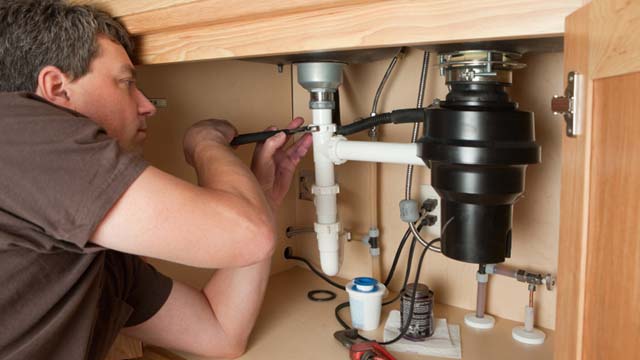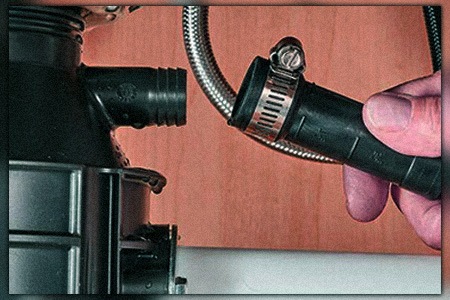How do you actually feel with regards to Why Is ?

Garbage disposals are important kitchen area home appliances that help in getting rid of food waste successfully. However, a dripping waste disposal unit can be an aggravating and messy issue to manage. Fortunately, numerous leakages can be taken care of conveniently with a few straightforward actions. In this article, we will certainly go over how to deal with a leaking garbage disposal effectively.
Introduction
Waste disposal unit are set up under kitchen sinks and are made to shred food waste right into smaller sized pieces, permitting it to travel through the pipes system conveniently. While these gadgets are typically trusted, leaks can occur in time because of damage, loosened connections, or damages to the system.
Usual Causes of Leaks in Garbage Disposals
Worn Seals and Gaskets
Seals and gaskets play an essential duty in protecting against water from leaking out of the waste disposal unit. Gradually, these elements can wear away, resulting in leaks around the disposal unit.
Loose Connections
The connections in between the waste disposal unit and the plumbing system can become loosened over time, causing water to leak out during operation.
Splits or Holes in the Disposal System
Physical damage to the garbage disposal, such as splits or holes in the real estate, can additionally lead to leakages.
Identifying the Resource of the Leak
Prior to attempting to repair a dripping garbage disposal, it is vital to determine the source of the leak. This can commonly be done with visual assessment or by conducting simple examinations.
Visual Assessment
Evaluate the garbage disposal system thoroughly for any type of indicators of water leakage. Pay attention to areas around seals, gaskets, and link points.
Testing for Leaks
One way to examine for leaks is by running water through the disposal system and checking for any kind of noticeable signs of leakage.
Devices and Products Needed for Taking Care Of a Leaking Waste Disposal Unit
Before starting the repair service process, gather the essential tools and materials, including a screwdriver, flexible wrench, plumbing professional's putty, substitute seals or gaskets, and epoxy or patching product for fixing splits or openings.
Step-by-Step Overview to Taking Care Of a Leaking Garbage Disposal
Turn Off the Power
Before attempting any type of repairs, make certain that the power to the waste disposal unit device is turned off to stop the danger of electric shock.
Situate the Leak
Identify the precise location of the leak and identify the cause.
Tighten up Connections
Utilize a wrench to tighten any type of loosened connections between the disposal unit and the plumbing system.
Change Seals or Gaskets
If the leakage is due to worn seals or gaskets, get rid of the old elements and change them with brand-new ones.
Patching Cracks or Openings
For cracks or holes in the disposal unit, use epoxy or an ideal patching material to seal the broken area.
Evaluating the Garbage Disposal After Repair
Once the repair work is complete, check the waste disposal unit by running water through it to guarantee that the leak has been dealt with.
Preventive Upkeep Tips to Stay Clear Of Future Leakages
To prevent future leakages, it is important to execute normal upkeep on your waste disposal unit. This includes maintaining it clean, preventing putting non-food products or hard items down the disposal, and occasionally checking for leaks or various other problems.
Final thought
In conclusion, repairing a leaking garbage disposal is a relatively uncomplicated process that can be completed with basic tools and materials. By complying with the actions outlined in this post and exercising precautionary maintenance, you can maintain your waste disposal unit in good working problem and prevent costly repairs in the future.
What to Do About a Leaking Garbage Disposal
A leaking garbage disposal often goes unnoticed until you confront a sopping cabinet, a foul-smelling puddle, or an audible drip-drip-drip from the unit. The fix can be frustrating, too, because the leak can stem from a number of components in the system. Fortunately, with a little sleuthing, you can zero in on the leak and—depending on the exact location—stop the icky oozing and repair the component that caused it. Worst case scenario, if it turns out that the garbage disposal must be replaced, installing a new one is a reasonable do-it-yourself task for those with basic plumbing skills. Read on to keep the cash you’d otherwise hand over to a pro.
Prepare to find the leak
Prior to testing the garbage disposal for leaks, unplug it at the wall outlet and turn off the power from the breaker box to prevent electrical shock. Then insert a watertight sink stopper into your sink drain and wipe the unit dry with a clean cloth. In any handy container, mix a few drops of food coloring into a few cups of water, and pour the dyed water onto the sink stopper to help you locate the leak.
Investigate the source
the top, where the disposal meets the sink drain the side, where the dishwasher hose or main drain pipe connects to the disposal or the bottom of the unit Inspect each of these locations while gliding a light-colored rag over the unit; the dyed water will readily show on the rag and reveal the location of the leak. If a leak isn’t immediately apparent, remove the sink stopper and pour a few more cups of dyed water down the sink drain, then check for leaks again. Leaks near the top of the unit are more likely to show themselves while the sink is plugged, while side and bottom leaks are more noticeable while the sink is unplugged.
The metal sink flange that sits directly inside the sink drain is typically sealed around the top with plumber’s putty (a clay-like sealant) and then secured from under the sink with bolts. If the plumber’s putty deteriorates, or the bolts loosen, the flange can no longer form a watertight seal between the sink drain and the disposal—which could cause a leak at the top of the unit.
To reseal the leaky flange, you must first detach the garbage disposal. Start by loosening the screws securing the main drain pipe to the disposal, then loosen the screws in the metal clamp securing the dishwasher hose to the disposal and detach the drain pipe and dishwasher hose from the disposal. Loosen the screws in the mounting ring that connects the disposal to the metal mounting assembly beneath the sink, then pull down the disposal and carefully set it on a clean, dry surface. Loosen the bolts in the mounting assembly with a wrench, then pull down the mounting assembly and set it near the disposal.

We hope you enjoyed our excerpt about Why Is My Garbage Disposal Leaking From the Bottom?. Thanks so much for finding the time to read our article post. Liked our blog? Please share it. Let others check it out. We enjoy reading our article about The Handy Guide To Fixing Your Garbage Disposal Leaking.
Click On This Link